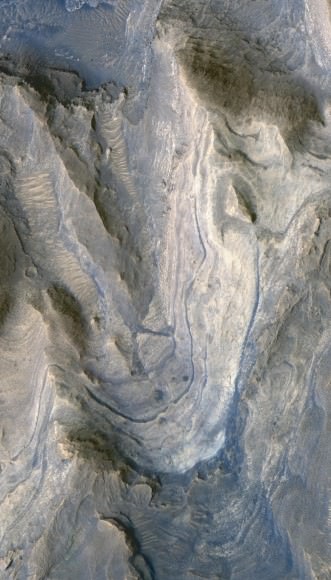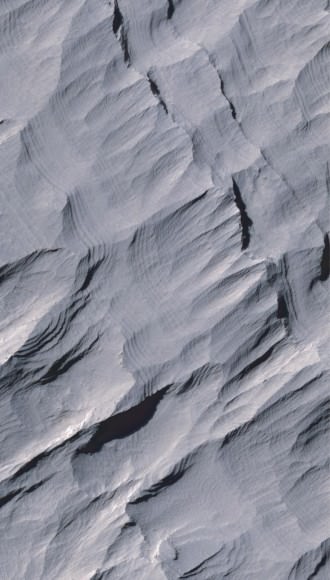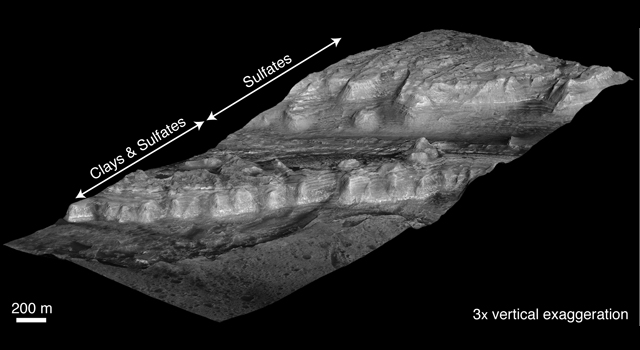[/caption]
Is Mars more like a Peanut Buster Parfait, a granola-yogurt parfait, –or perhaps — maybe a seven-layer salad? Near the center of a Martian crater about the size of Connecticut, hundreds of exposed rock layers form a mound as tall as the Rockies and reveal a record of major environmental changes on Mars billions of years ago. According to a new report by geologists using instruments on the Mars Reconnaissance Orbiter to look at the “parfait” of layers inside Gale Crater, the layers show that Mars was likely wet at one point, but gradually dried over time.
“Looking at the layers from the bottom to the top, from the oldest to the youngest, you see a sequence of changing rocks that resulted from changes in environmental conditions through time,” said Ralph Milliken from JPL. “This thick sequence of rocks appears to be showing different steps in the drying-out of Mars.”

Milliken and two co-authors of a paper in Geophysical Research Letters say that clay minerals, which form under very wet conditions, are concentrated in layers near the bottom of the Gale stack. Above that, sulfate minerals are intermixed with the clays. Sulfates form in wet conditions and can be deposited when the water in which they are dissolved evaporates. Higher still are sulfate-containing layers without detectable clays. And at the top is a thick formation of regularly spaced layers bearing no detectable water-related minerals.

Rock exposures with compositions like various layers of the Gale stack have been mapped elsewhere on Mars, and researchers, including Jean-Pierre Bibring of the University of Paris, have proposed a Martian planetary chronology of clay-producing conditions followed by sulfate-producing conditions followed by dry conditions. However, Gale is the first location where a single series of layers has been found to contain these clues in a clearly defined sequence from older rocks to younger rocks.
“If you could stand there, you would see this beautiful formation of Martian sediments laid down in the past, a stratigraphic section that’s more than twice the height of the Grand Canyon, though not as steep,” said Bradley Thomson of the Johns Hopkins University Applied Physics Laboratory, Laurel, Md. He and John Grotzinger of the California Institute of Technology in Pasadena are Milliken’s co-authors.
NASA selected Gale Crater in 2008 as one of four finalist sites for the Mars Science Laboratory rover, Curiosity, which has a planned launch in 2011. The finalist sites all have exposures of water-related minerals, and each has attributes that distinguish it from the others. This new report is an example of how observations made for evaluating the landing-site candidates are providing valuable science results even before the rover mission launches.


This is really exciting stuff! How’s ‘absolutely awesome’ sound?
First off, Gale’s the place for our Curiosity! Well, maybe not, but sometimes one can go purely emotional. We will have years to really choose, IIRC.
Second, if Mars have been so consistently wet, I believe the likelihood to find early life (if so only by isotope ratios) skyrockets.
[I dearly hope ‘Marstronomers’ have found a way to bracket the different eras seen! I’ll have to go see.]
Third, I normally don’t complain about US centric memes, even in “universal” blogs. But today I find myself waylaid by a rapid-fire of them. You have peanut parfaits? [shudder]
Granola, …, er, dictionary says it’s “rolled oats with stuff”. Check. Seven-layer salad, …? Not only can’t peanut parfait provoke an imagery for me, I’m not sure I would like it to! 😉
To me it looks like a hefty stack of european style thin pancakes which is under consumption. You can put cream and jam in between to make it a dessert. “Dessert Mars”, huh?
This sedimentary structure and evidence of past life suggests that either the chemical conditions for the development of life existed in the past, with possible signatures remaining, or that life developed. if life developed it is then possible life continues on mars. it may persist by adapting to subterrainian (submartianian?) regions, stubbornly clinging to existence.
LC
I have looked at Milliken’s et al interesting paper, and they conclude that Gale crater features are consistent with a scenario by Birbring et al. In that scenario the clay-to-sulfate formation transition is captured along the Noachian-Hesperian boundary, as measured by cratering rates in and around Gale crater.
That means the transition is ~ 3.5 Ga, or around the time when there are tentative bio-signatures on Earth! Everything else alike, the likelihood for life on Mars should AFAIU have improved.